glenn bradley
Member
- Messages
- 11,568
- Location
- SoCal
I was gifted this table and wanted to share the initial experiences with it. When I first saw it I pondered making something myself that could do the job . . . I just never got around to it. Probably just as well since the table is well thought out and fairly functional as designed.
Let me start by saying I am a long time Lee Valley fan and sing their praises. I also call folks out when they fall short. That being said . . . The base is made of CNC cut plywood pieces. The cuts were very crude and I had to do a fair amount of sanding to get things to where one wouldn't get a plywood splinter (I hate plywood splinters) while moving the rig from storage to work area and back. As long as I was at it I slapped on some shellac and sanding things very smooth. It looked like the CNC cutters were overdue for change out. Not what I normally expect and get from Lee Valley.
The slots in the laminate were clean but the threaded inserts were less so. Some holes were "starred" and not well cut. A couple were misaligned and I had to fuss about a bit to get the stud-knobs to thread in in a usable fashion.
The split fence and Domino 500 mount method works well. Having a 36" straight edge on hand makes setting things up pretty quick. A downside is that the tool needs to be aligned every time you remove it. I went looking for a used DF-500 nose piece to just leave on the table but so far . . . no soap.
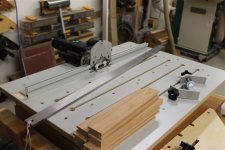
The base offers a lot of options to clamp the unit down. You could even catch it between a vise chop and some bench dogs. I use a couple of clamps.

The center indicator has the same weakness in the table as it does in the hand. With the fence up the center-line does not extend far enough to use without "eye balling" things. I use a small square to extend the Domino's mark to the layout line on the material. If your material is ~3/4" (~18mm) you can flip the fence down and use the cursor. Thicker and thinner material . . . not so much. Here I have cut a mortise in the center of a divider. There is a mortise centered at both ends so I just flip the piece and cut.
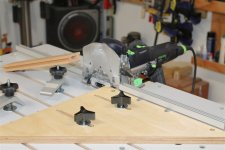
For asymmetrical mortises like these stiles you setup for one position and cut all the similar ends.
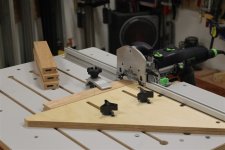
You then use the offset tool to create a reference tool for the plywood fence. This is done by inserting the offset tool into the proivided hole in the fence, sliding the rod until the stop touches the Domino dog and locking that dimension down.
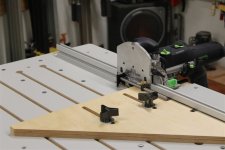
You flip the fence 180 degrees which requires removing the knobs, flipping the fence and re-installing the knobs.

You now insert the offset tool in the provided hole (brass insert present for reliability) and slide the fence up till the offset tool touches the opposite Domino dog.
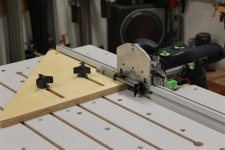
This lets you cut a mortise in the mirror image position from the previous mortise.

The same setup sans fence can be used to cut the mortises in the rails.
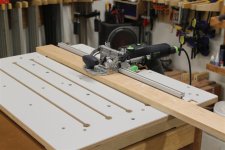
And you very quickly end up here.
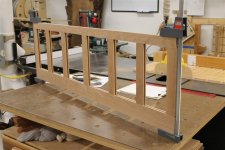
For a lot of mortises on similar parts (I had 26 of one set, 4 of another, and 28 of yet another) I would say the table setup is well worth the time required. For 3 or 4 mortises I would not bother. Much like a dovetail jig that pays off for 7+ drawers but not really for 1 or 2.
Overall I would give it a thumbs up. The fit and finish could use some work at this price point ($300+ IIRC) but there is nothing on the kit as received that takes too much effort to dial in.
Let me start by saying I am a long time Lee Valley fan and sing their praises. I also call folks out when they fall short. That being said . . . The base is made of CNC cut plywood pieces. The cuts were very crude and I had to do a fair amount of sanding to get things to where one wouldn't get a plywood splinter (I hate plywood splinters) while moving the rig from storage to work area and back. As long as I was at it I slapped on some shellac and sanding things very smooth. It looked like the CNC cutters were overdue for change out. Not what I normally expect and get from Lee Valley.
The slots in the laminate were clean but the threaded inserts were less so. Some holes were "starred" and not well cut. A couple were misaligned and I had to fuss about a bit to get the stud-knobs to thread in in a usable fashion.
The split fence and Domino 500 mount method works well. Having a 36" straight edge on hand makes setting things up pretty quick. A downside is that the tool needs to be aligned every time you remove it. I went looking for a used DF-500 nose piece to just leave on the table but so far . . . no soap.

The base offers a lot of options to clamp the unit down. You could even catch it between a vise chop and some bench dogs. I use a couple of clamps.

The center indicator has the same weakness in the table as it does in the hand. With the fence up the center-line does not extend far enough to use without "eye balling" things. I use a small square to extend the Domino's mark to the layout line on the material. If your material is ~3/4" (~18mm) you can flip the fence down and use the cursor. Thicker and thinner material . . . not so much. Here I have cut a mortise in the center of a divider. There is a mortise centered at both ends so I just flip the piece and cut.

For asymmetrical mortises like these stiles you setup for one position and cut all the similar ends.

You then use the offset tool to create a reference tool for the plywood fence. This is done by inserting the offset tool into the proivided hole in the fence, sliding the rod until the stop touches the Domino dog and locking that dimension down.

You flip the fence 180 degrees which requires removing the knobs, flipping the fence and re-installing the knobs.

You now insert the offset tool in the provided hole (brass insert present for reliability) and slide the fence up till the offset tool touches the opposite Domino dog.

This lets you cut a mortise in the mirror image position from the previous mortise.

The same setup sans fence can be used to cut the mortises in the rails.

And you very quickly end up here.

For a lot of mortises on similar parts (I had 26 of one set, 4 of another, and 28 of yet another) I would say the table setup is well worth the time required. For 3 or 4 mortises I would not bother. Much like a dovetail jig that pays off for 7+ drawers but not really for 1 or 2.
Overall I would give it a thumbs up. The fit and finish could use some work at this price point ($300+ IIRC) but there is nothing on the kit as received that takes too much effort to dial in.
